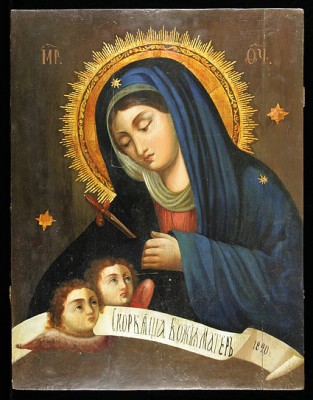
Scripture: Lectionary # 639. September 15, Feast of Our Lady of Sorrows:
Hebrews 5:7-9. Psalm 31:2-3.3-4.5-6.15-16.20. John 19:25-28 or Luke
2:33-35
The two passages from the Gospels of Luke are always associated with the
celebration of this feast. However, the scene at the foot of the Cross is
the mystery of Jesus that associates her with profound sorrow as he is
dying on the Cross. Simeon’s words recorded by Luke are a shadow or
foretelling of the great tragedy of Calvary so clearly expressed in John
with Mary and the Beloved Disciple standing next to each other at the foot
of the Cross.
One of the doctoral students at the International Marian Research Institute
here on the campus of the University of Dayton has researched this text of
John and as a Servite he is proving and reclaiming that this is the center
of the devotion and feast of Our Lady of Sorrows.
Our feast has a long tradition going back to the seven Servites who were
the founders and first members of the Servants of Mary (O.S.M.). It is they
who have handed down this devotion and commemoration in the liturgy.
Churches and shrines dedicated to the Sorrowful Mother are in existence
because of the Servites.
Five of the seven sorrows are directly taken from the Gospels of Matthew,
Luke, and John while the other two are from our living and faithful
traditions about Mary in the life of her son. Scripture and Tradition go
together in our celebration of this feast honoring Mary. It is fitting that
it also occurs on the day after the feast of the Exaltation of Jesus upon
the Cross.
Here are the seven sorrows of Mary with their corresponding references:
Simeon’s foretelling of the heart of Mary being pierced by a sword (Luke
2:33-35).
The flight of the holy family (Jesus, Mary, and Joseph) into Egypt
(Matthew 2:13-18).
The loss of the child Jesus in the Temple in Jerusalem (Luke 2:41-52).
The Fourth Station of the Cross: Jesus meets his mother on the way to
Calvary ( Tradition and devotion).
Jesus dies on the Cross (John 19:25-28).
Mary receives the body of Jesus taken from the Cross (the Pieta in St.
Peter’s, art and sculpture).
Jesus is placed in the tomb ( our Creed, all four Gospels have the
burial of Jesus)
There is a great Hymn called a Sequence that is attached to the celebration
in the readings. It is also centered on the scene at the foot of the Cross
and is called the “Stabat Mater” the mother is standing there. For us it
can be prayed and meditated upon since it does enter into the feelings of
the Mother of Jesus and expresses them so well in a poetic Latin. The
translations in English are very good. Amen.
Scripture: Lectionary # 446: I Timothy 4:12-16. Psalm 111:1-2,16-17.28.
Luke 7:36-50
“Little is forgiven the one whose love is small.” We learn how an unnamed
woman loves much and how Jesus shows his gratitude for her actions. She
does not speak in this scene where she, Jesus, and Simon, a Pharisee are
present in the home of the latter, Simon. It is a magnificent scene
present in the other Gospels but not as beautifully and spiritually as we
hear and read in Luke.
Simon invites Jesus to dine but is careless and inattentive to Jesus. He
forgets to offer water to bathe his feet and remove the dust before dining.
Hospitality is one of the greatest of customs and virtues in the Semitic
world and to forget the ordinary rituals is a sign that something was not
right. Fortunately, an unnamed woman somehow enters the home of Simon and
performs the washing of Jesus feet with her tears, the drying of them with
her hair and then anoints them with a precious perfume or oil. Jesus then
takes this loving action on her part as a moment for teaching Simon an
important lesson. As usual, Jesus does this through a parable that
underlines forgiveness. Simon interprets the parable correctly and
probably improved on his hospitality the next time he invited a guest.
Simon also is thinking and judging both the woman and Jesus. She is judged
a sinner and Jesus should know this if he is a true prophet like Moses has
predicted. Jesus knows the inner moving of the heart of Simon and that of
the woman, therefore, he uses the parable to bring home an important point.
Jesus says to the woman, “Your sins are forgiven.” He experiences her love
and her trust in him so he shows his gratitude by these divine like words
for only God can forgive! The woman had perfect love for him and had no
fear of doing what she did in a home in which she was not invited. Simon,
on the other hand, may not have sinned but lacked the great and expected
virtue of a warmth of welcome.
We often hear of people who do not thank others for gifts or kind words.
This is similar to the lack of hospitality that Jesus experienced from
Simon. Maybe they never received this gift of gratitude from their own
parents and carry this inappropriate behavior in their dealings with people
who do something good for them but do not receive a thank you.
Jesus expresses his love for her by saying, “Your faith has been your
salvation. Now go in peace.” She had done what was necessary and would not
need further embarrassment from the other guests so when Jesus says to her,
“Go in peace” this means that she may leave; her great act of hospitality
has been done.
Is it not interesting to hear that Jesus did not say her love is what saves
her, but her faith? She already had great love for Jesus and does not love
because she has been forgiven; she is forgiven through her confidence and
faith that Jesus would accept her and he did. Though unnamed she is
forever remembered in our Scriptures and in our own hearts whenever this
Gospel is read or proclaimed. Jesus has done this for us in memory of her.
Amen.
About the Author

Lisa M. Hendey
Lisa M. Hendey is the founder of CatholicMom.com, a bestselling author and an international speaker. A frequent radio and television guest, Hendey travels internationally giving workshops on faith, family, and communications. Visit Lisa at LisaHendey.com, on her Substack at LisaHendey.Substack.com, or on social media @LisaHendey for information on her speaking schedule or to invite her to visit your group, parish, school or organization. Find Lisa’s books on her Amazon author page.


.png?width=1806&height=731&name=CatholicMom_hcfm_logo1_pos_871c_2728c%20(002).png)
Comments